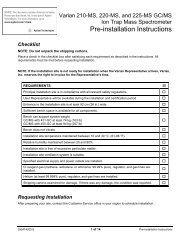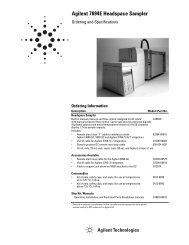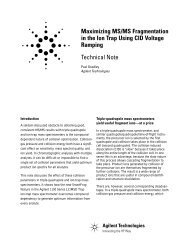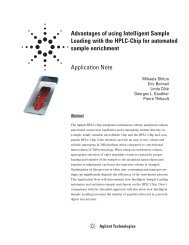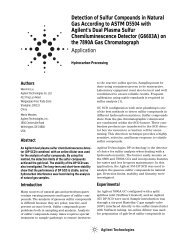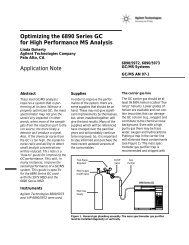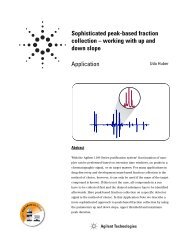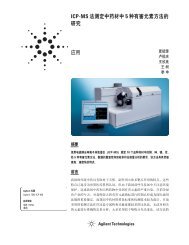Specific Determination of Bromate and Iodate in Ozonized Water by ...
Specific Determination of Bromate and Iodate in Ozonized Water by ...
Specific Determination of Bromate and Iodate in Ozonized Water by ...
You also want an ePaper? Increase the reach of your titles
YUMPU automatically turns print PDFs into web optimized ePapers that Google loves.
a) BrO 3 -<br />
15<br />
y = 6.3702x -0.5158<br />
RSD / %<br />
10<br />
5<br />
0<br />
R 2 = 0.6307<br />
0 5 10 15 20 25<br />
concentration / µg/L<br />
b) IO 3 - 15<br />
y = 1.5814x -0.6177<br />
RSD / %<br />
10<br />
5<br />
0<br />
R 2 = 0.9492<br />
0 0 .5 1 1 .5 2 2 .5<br />
concentration / µg/L<br />
Fig. 2<br />
Relationships between the RSD <strong>and</strong> sample concentration for bromate a) <strong>and</strong> iodate b).<br />
Experimental conditions are same as those given <strong>in</strong> Fig. 1.<br />
RSD values which were calculated<br />
for each set <strong>of</strong> 10 measurements<br />
<strong>of</strong> bromate <strong>and</strong> iodate solutions<br />
at various concentrations.<br />
Fig. 2 shows the relationships<br />
between the RSD <strong>and</strong> the sample<br />
concentration. The concentrations<br />
<strong>of</strong> bromate <strong>and</strong> iodate at 10 % <strong>of</strong><br />
RSD were 0.42 µg/L <strong>and</strong> 0.051 µg/L,<br />
respectively. Fig. 2 also shows the<br />
signal stability <strong>in</strong> the concentrations<br />
which give sufficient sensitivity<br />
for bromate <strong>and</strong> iodate.<br />
In both species, RSDs were<br />
saturated around 1% even <strong>in</strong> high<br />
concentrations. The saturated<br />
RSD is considered to be affected<br />
<strong>by</strong> ICP-MS stability.<br />
Interference <strong>by</strong> coexistent substance<br />
The <strong>in</strong>terference from coexistent<br />
substances such as chloride,<br />
sulfate <strong>and</strong> nitrate has been<br />
reported <strong>by</strong> Creed <strong>and</strong> others[14].<br />
They reported that bromate can<br />
be determ<strong>in</strong>ed <strong>in</strong> a chloride matrix<br />
with 5-6 orders <strong>of</strong> magnitude<br />
higher. However, a retention time<br />
shift for bromate <strong>in</strong> 1000 mg/L <strong>of</strong><br />
chloride matrix was observed. So,<br />
the <strong>in</strong>terference from coexistent<br />
substances such fluoride, chloride,<br />
nitrite, phosphate <strong>and</strong> sulfate was<br />
exam<strong>in</strong>ed. Mixed anion st<strong>and</strong>ard<br />
solutions rang<strong>in</strong>g <strong>in</strong> concentration<br />
from 5 to 50 mg/L <strong>of</strong> anions<br />
were <strong>in</strong>jected. Peaks <strong>of</strong> these<br />
anions were not observed on the<br />
chromatogram. The retention time<br />
shift for halogen anions <strong>in</strong> the<br />
concentration below 50 mg/L <strong>of</strong><br />
anions matrix was not observed.<br />
However, one peak was observed<br />
at void volume <strong>in</strong> chromatogram<br />
<strong>of</strong> 79 amu. This peak was<br />
recognized to be a polyatomic ion<br />
( 40 Ar 39 K+) formed <strong>by</strong> comb<strong>in</strong>ation<br />
<strong>of</strong> potassium <strong>in</strong> sample solution<br />
with argon as the plasma gas,<br />
because it appeared at the<br />
retention time <strong>of</strong> potassium<br />
that was observed <strong>in</strong> 39 amu.<br />
Conclusively, this peak due to<br />
potassium will be neglected on the<br />
determ<strong>in</strong>ation <strong>of</strong> bromate because<br />
it is eluted at the void volume <strong>of</strong><br />
the anion exchange column <strong>and</strong><br />
completely separated from that <strong>of</strong><br />
bromate under these separation<br />
conditions.<br />
Application to the determ<strong>in</strong>ation <strong>of</strong><br />
halogen anions <strong>in</strong> the water<br />
The presented method was<br />
applied to the determ<strong>in</strong>ation <strong>of</strong><br />
halogen anions <strong>in</strong> several water<br />
samples. The chromatograms <strong>of</strong><br />
the ozonized water <strong>by</strong> us<strong>in</strong>g<br />
IC-ICP/MS <strong>and</strong> the postcolumn<br />
derivatization were shown <strong>in</strong> Fig. 3.<br />
The determ<strong>in</strong>ed concentrations<br />
<strong>of</strong> halogen anions <strong>in</strong> raw (river)<br />
<strong>and</strong> ozonized water are listed <strong>in</strong><br />
Table 3. The concentrations <strong>of</strong><br />
halogen anions determ<strong>in</strong>ed <strong>by</strong><br />
both method were relatively <strong>in</strong><br />
agreement. However, some iodate<br />
values obta<strong>in</strong>ed us<strong>in</strong>g ICP-MS<br />
were slightly higher than that <strong>of</strong><br />
postcolumn derivatization. The<br />
disagreement could be due to<br />
lack <strong>of</strong> precision <strong>in</strong> such low<br />
concentration. Furthermore,<br />
there could be <strong>in</strong>terference from<br />
other iod<strong>in</strong>e-conta<strong>in</strong><strong>in</strong>g species<br />
coelut<strong>in</strong>g with iodate, because<br />
ICP-MS would detect any species<br />
conta<strong>in</strong><strong>in</strong>g iod<strong>in</strong>e, <strong>and</strong> it would<br />
give positive error <strong>in</strong> the iodate<br />
values. <strong>Bromate</strong> values <strong>by</strong> ICP-MS<br />
were a little lower than that <strong>of</strong><br />
postcolumn method. The reason is<br />
4



